The Travel Advertising Market is estimated to be valued at USD 12.7 billion in 2025 and is projected to reach USD 30.6 billion by 2035, registering a compound annual growth rate (CAGR) of 9.1% over the forecast period.
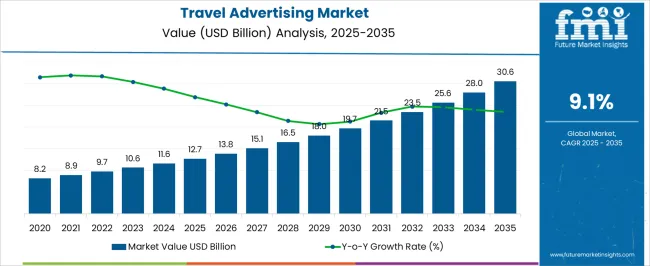
| Metric | Value |
|---|---|
| Travel Advertising Market Estimated Value in (2025 E) | USD 12.7 billion |
| Travel Advertising Market Forecast Value in (2035 F) | USD 30.6 billion |
| Forecast CAGR (2025 to 2035) | 9.1% |
The travel advertising market is expanding steadily, supported by the resurgence of global travel, rising consumer spending on leisure and business trips, and technological advancements in media outreach. Industry publications and corporate earnings calls have highlighted a sharp rebound in advertising budgets among airlines, hotels, and tourism boards, reflecting intensified competition for traveler attention.
Traditional and digital media channels have both been leveraged to increase destination visibility, with storytelling-based campaigns and targeted advertisements gaining prominence. Television and online platforms continue to command strong influence due to their ability to deliver mass outreach and targeted engagement, respectively.
In addition, the return of business travel has reinvigorated spending by corporate travel service providers, while the rise of domestic tourism has ensured steady baseline demand across mature and emerging markets. Future growth of the sector is expected to be driven by data-driven advertising strategies, immersive technologies such as augmented reality campaigns, and sustainability-focused messaging to attract environmentally conscious travelers.
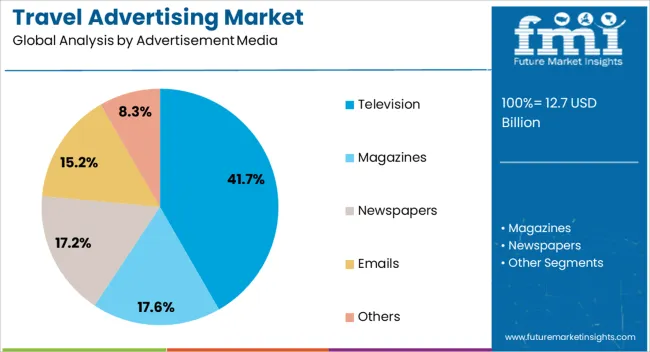
The Television segment is projected to account for 41.7% of the travel advertising market revenue in 2025, sustaining its leadership as the most influential advertising medium. Growth in this segment has been attributed to television’s capacity to deliver large-scale visibility, emotional storytelling, and trust-building among diverse audiences.
Travel companies have continued to invest in television campaigns due to its effectiveness in showcasing destinations and experiences through high-quality visuals. Additionally, live broadcasts and prime-time slots have enabled brands to capture peak viewership, ensuring strong consumer recall.
While digital platforms are gaining traction, television remains a reliable medium for building brand image and credibility, particularly among audiences less engaged with online channels. Its integration with cross-media campaigns has further reinforced television’s dominant role in travel advertising.
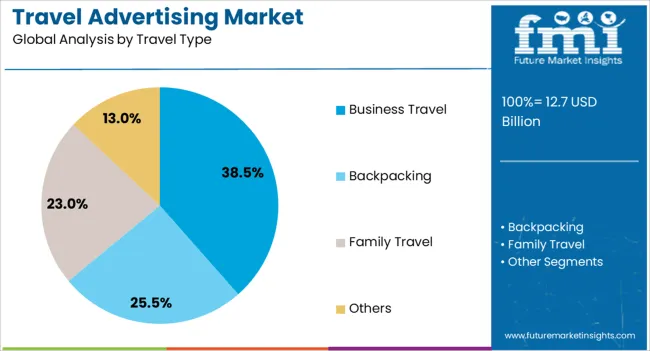
The Business Travel segment is projected to contribute 38.5% of the travel advertising market revenue in 2025, reflecting its critical role in driving premium demand for flights, accommodations, and ancillary services. This segment’s prominence has been reinforced by the revival of corporate travel following global restrictions, as companies resume in-person meetings, conferences, and trade shows.
Advertising campaigns targeting business travelers have emphasized convenience, connectivity, and loyalty programs, aligning with the priorities of frequent travelers. Industry announcements have noted increased investment by airlines and hotel chains in business-focused advertising to regain market share.
Additionally, the high-value nature of business travel, often associated with premium bookings and repeat customers, has strengthened advertising emphasis on this segment. As hybrid work models stabilize, continued corporate demand for international and domestic business trips is expected to sustain growth in this category.
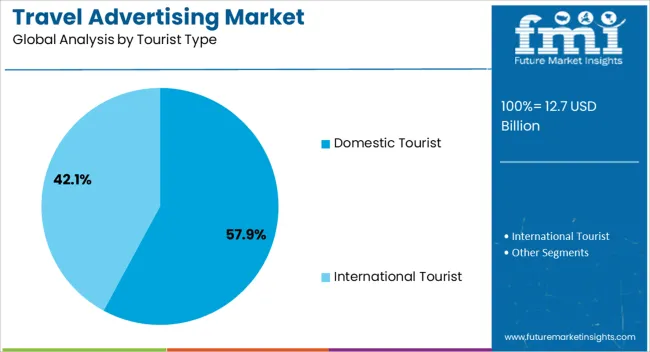
The Domestic Tourist segment is projected to hold 57.9% of the travel advertising market revenue in 2025, positioning it as the largest contributor among tourist categories. Growth in this segment has been driven by the steady demand for local and regional travel, supported by affordability, ease of accessibility, and government initiatives promoting domestic tourism.
Travel boards and hospitality companies have prioritized advertising campaigns that highlight local heritage, cultural experiences, and weekend getaway destinations to attract domestic travelers. Reports from the tourism sector have emphasized that domestic tourists form the backbone of travel demand in many countries, offering resilience against international travel disruptions.
Additionally, domestic travel has been favored due to shorter planning cycles, lower costs, and increasing emphasis on sustainable tourism. As consumer interest in rediscovering local destinations continues to rise, the Domestic Tourist segment is expected to maintain its leadership in shaping travel advertising strategies.
The travel advertising market has historically developed at a CAGR of 5.9%. However, travel deals have started advancing at a trifling pace, displaying a CAGR of 9.2% from 2025 to 2035.
| Attributes | Details |
|---|---|
| Historical CAGR for 2020 to 2025 | 5.9% |
Consumer preference for emotional resonance over factual information in holiday choices presents opportunities for marketers to embrace longer formats, videos, and personal stories for deeper audience connection.
Post-pandemic, there has been a noticeable surge in people's desire to explore different places in the world. This growing interest in global exploration presents a promising opportunity for the tourism industry.
The travel and tourism sector, a vital part of the global economy, faced significant challenges during the pandemic. This is leading to consumers canceling vacations for shelter, but recovery began in 2024.
The lifting of lockdown restrictions between 2025 and 2025 has led to a surge in pent-up demand in the travel and hospitality industry, prompting companies to promote their services actively.
Before 2024, the demand for travel advertising thrived, with digital and online methods being the top methods used by top agencies to attract travelers and pitch new offers and tour packages. Businesses may now traverse the post-pandemic travel industry owing to marketers' ability to reach their target audience and generate conversions through the move toward digital channels.
Tourism companies and brands are recognizing the value of collaborative strategies with local establishments. These partnerships not only help in advertising their brand but also contribute to the development of a diverse consumer base. By leveraging the unique offerings of these local establishments, tourism companies, and brands can create more engaging and authentic experiences for their customers.
Widespread Demand for AI-generated Advertisements Trends in Tourism Sector
Travel advertising giants are increasingly utilizing artificial intelligence in sales and marketing. They are investing in AI chat boxes that can answer basic questions and learn new facts based on customer responses. AI has also been instrumental in industry research and data collection.
The tourism industry is embracing personalized advertising using CGI and AI-powered background music. This enhances the effectiveness of marketing campaigns by creating unique and engaging content that resonates with individual users.
Organizations use AI chatbots to interact with customers and guide them through website searches. These chatbots are programmed to answer specific questions and provide answers. This, in turn, allows customers to choose to speak with an operator or helpline. Additionally, AI chatbots learn new facts based on customer responses. This trend is becoming increasingly prevalent among big players in the industry.
Major travel troupes are embracing AI to enhance customer service operations. Expedia and Booking.com launched AI travel planners powered by ChatGPT in April 2025, adding a layer of sophistication to their offerings.
AR and VR Tours Gains Momentum in Virtual Travel Sector
AR and VR technologies are revolutionizing the travel industry by allowing companies to offer virtual tours of facilities and showcase attractions, enhancing pre-travel excitement and allowing potential customers to explore amenities and ambiance before booking.
Climate change and biodiversity loss threaten countries, leading to reduced tourist intake. To combat this, AR and VR platforms are promoting biodiversity by displaying top tourist spots on virtual screens, encouraging sustainable tourism and attracting more travelers.
The software collects data from tourists' journeys, creating a list of preferences. This data is processed and recommended to future consumers, enhancing experiences and assisting in problem-solving, thereby enhancing businesses' competitiveness in the travel industry.
Rise of Eco-tourism in Developing Countries
Eco-conscious travelers are seeking sustainable travel options, with 70% of travelers believing there are not enough alternatives. The ecological shift in behavior is a compelling change in the travel industry and marketing efforts. Eco-tourism is an emergent trend, with marketers focusing on highlighting destinations and accommodations that prioritize sustainability.
Younger generations of travelers, particularly Gen Z and millennials, are most concerned about sustainable travel, so marketing efforts should align with their preferred platforms and content styles, such as TikTok, Instagram, and YouTube. This shift in behavior drives changes in the industry and marketing efforts.
Exhaustive assessments of the segments for advertisement in the travel and tourism industry are provided in the section that follows. While there is a substantial demand for newspaper advertising, there is projected to be an uptick in family travel in 2025.
| Attributes | Details |
|---|---|
| Top Advertising Media | Newspaper |
| Revenue share in 2025 | 33.7% |
With a revenue share of 33.7% in 2025, the newspaper media dominated the advertising of the travel and touring industry by advertising media.
Travel brochures and flyers in magazines and newspapers, which function as both visual and tangible forms of tourist advertising, are becoming less effective due to the rise of social media and the internet.
Since it may enhance other advertising initiatives and raise brand recognition, newspaper advertising is becoming more and more popular. However, industry development must be aided by the quick digitization of media, the move from print to electronic channels, and the fierce rivalry among print advertising providers.
The growth of print advertising is foreseen to be forced by the need for creative and interactive advertising, along with improvements in printing technology like augmented printing and paper manufacturing.
The pandemic, however, has impacted core newspaper advertisers, leading to reduced marketing budgets and declining advertising revenue.
| Attributes | Details |
|---|---|
| Top Travel Type | Family Travel |
| Revenue share in 2025 | 27.4% |
The tourism sector is responding to the demand for family travel, which is envisioned to acquire 27.4% industry share in 2025. The share is propelled by the need for novel tour packages, particularly tailored to families and backpackers. Family travel offers a chance to bond, explore, and create memories, and travel marketers are creating customized, family-friendly tour packages to cater to this growing demand.
Family travel offers numerous benefits, including creating lifelong memories and teaching children about different cultures. Family travelers, often consisting of multiple generations, are a lucrative target for tourism organizations, while backpackers, typically young and adventurous, are drawn to unique and off-the-beaten-path experiences. These two categories are the easiest and most common target of advertisement organizations in the tourism industry.
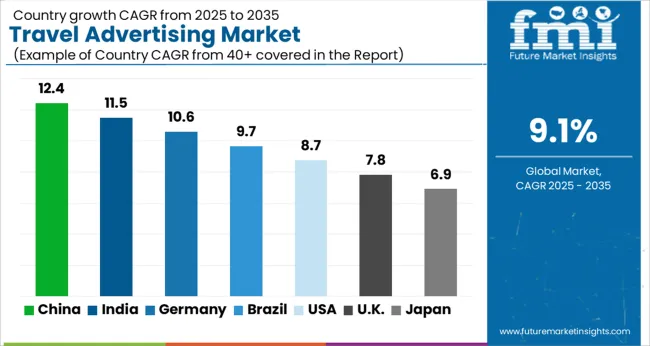
The travel-advertising segment is supporting the development of the tourism sectors of different countries. The demand for advertisements to attract global tourists is gaining momentum in India. Whether the need for tourism advertisement is inferior in Germany, by comparing with others.
The tourism industry in China has developed significant improvements in the field owing to its diverse culture. The adventure traveling of Australia indulges the advertisement, and the United States creates a sophisticated consumer base for the industry.
The effects of the pandemic in 2024 reduced travel advertising spending in the United States. By the end, though, the industry bounced back and averaged levels more akin to those before the epidemic. Luxury travel increased in early 2025 owing to effective advertisements. Digitization is a major factor in the industry's current development, which is changing the travel and tourist scene.
Travelers more and more planning their trips, such as researching places and making reservations for activities, lodging, and transportation, are using digital resources. By 2035, the travel advertising market is predicted to have a CAGR in digital ad spending of 5.3%, mostly because of advanced social media advertising investment.
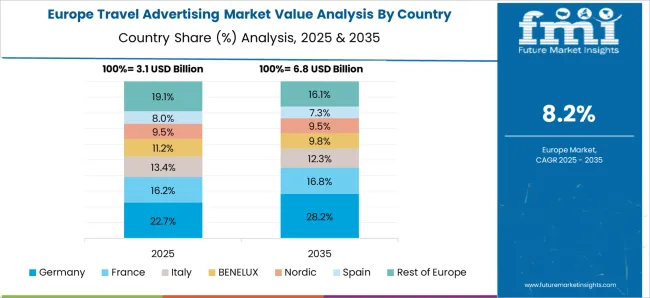
In Germany, location-based advertisements are more relevant and interesting, with businesses focusing on historical sites and rural areas with a variety of biological features. This strategy works especially well for winter sports lodging in Bavaria, which serves colder regions looking for skiing and winter vacations.
A CAGR of 4.6% is predicted for Germany's travel advertising market between 2025 and 2035 because of rising interest in customized trips in particular areas and backpacking. This makes it possible for German businesses to spend their money more wisely and where it will most likely result in a conversion.
With a projected value of USD 12.7 billion in travel and tourism-related GDP in 2025, China comes in second place internationally. It also tops the list in terms of employment, having added 66,086,000 new jobs in 2014. Chinese tourists are moving away from typical vacation packages and toward customized choices in search of more distinctive experiences. Influencer marketing and social media influence customer preferences.
China's travel advertising market is developing a CAGR of 11.6% between 2025 and 2035. Because of improving infrastructure, greater interest in sustainable practices, and rising affluence, the Chinese travel and tourism industry is seeing a ripple effect in domestic travel.
Australia's travel advertising market, which is envisioned to register an 8.5% CAGR between 2025 and 2035, is anticipated to extend due to its attractive landscape and diverse activities available across various cities, indicating a promising future for the industry.
Government tourist programs and perceptive digital marketing are propelling growth in Australia's adventure tourism sector. On the other hand, hazards and erratic weather provide difficulties.
Adventure service companies may benefit greatly from social media networking since it attracts visitors from around the world through trip blogging and video recording on sites like Instagram and Twitter. In the upcoming years, this tendency is anticipated to fuel growth and draw more tourists to Australia.
India is a place that offers diversifying tourist attractions from the snowy mountains of the Himalayas to the Tropical climate of the Goa seashore. The advertising organizations in the country are developing different ads that glorify the diversity of destinations in India.
The Indian tourism industry relies heavily on digital strategies such as quality websites, SEO, email marketing, social media presence, content, and mobile-friendly websites. The travel advertising market in India is estimated to report a 13.2% CAGR from 2025 to 2035, enabling businesses to gain customers, reach new industries, enhance brand visibility, and boost bookings.
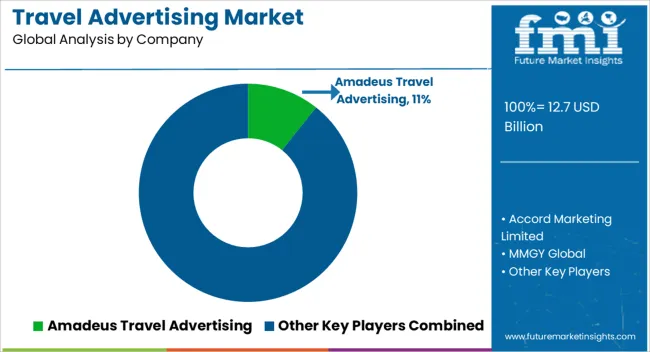
Travel advertising organizations provide a range of services to travel agencies, paramount in attracting tourists who are often planning their trips well in advance. These tourists, seeking guidance for their well-planned tours, are the ones the communities can help to reach.
The growth proposal for the travel advertising market involves the creation of a simple and interactive interface on the website. This interface is designed to enhance the user experience, allowing tourists to easily guide through their tour packages, view detailed itineraries, and even customize their trips. By implementing this interface, travelers can see desired destinations within their budgets. In order to meet the need for local tourism, advertisers in the HoReCa (Hotels, Restaurants, and Cafes) sector are required to work in tandem with local originalities.
With the assistance of advertising on social media in planning the design of the website, creating engaging content, and developing interactive ads, the tours and travel business can significantly boost their sales. Industry players are here to reassure the tourists that their services are designed to maximize the business potential and attract more customers.
Recent Developments in the Travel Advertising Sector
The industry mainly indorses in magazines, newspapers, television, emails, and other formats of media.
Depending on the travel types, the industry is branched into business travel, backpacking, family travel, and others.
Based on the tourist types, the industry is bifurcated into domestic and international.
The industry is examined across key regions including North America, Latin America, Europe, East Asia, South Asia, Oceania, as well as Middle East and Africa.
The global travel advertising market is estimated to be valued at USD 12.7 billion in 2025.
The market size for the travel advertising market is projected to reach USD 30.6 billion by 2035.
The travel advertising market is expected to grow at a 9.1% CAGR between 2025 and 2035.
The key product types in travel advertising market are television, magazines, newspapers, emails and others.
In terms of travel type, business travel segment to command 38.5% share in the travel advertising market in 2025.






Full Research Suite comprises of:
Market outlook & trends analysis
Interviews & case studies
Strategic recommendations
Vendor profiles & capabilities analysis
5-year forecasts
8 regions and 60+ country-level data splits
Market segment data splits
12 months of continuous data updates
DELIVERED AS:
PDF EXCEL ONLINE
Travel Pouches Market Size and Share Forecast Outlook 2025 to 2035
Travel Trailer Market Size and Share Forecast Outlook 2025 to 2035
Travel & Tourism User Generated Content Market Size and Share Forecast Outlook 2025 to 2035
Travel Bags Market Size and Share Forecast Outlook 2025 to 2035
Travel Vaccines Market Size and Share Forecast Outlook 2025 to 2035
Travel Accessories Market Analysis by Product Type, Material, Distribution Channel, End-User and Region 2025 to 2035
Travel Expenses Processing Market Analysis By Type, By End User, By Booking Channel, By Region Forecast: 2025 to 2035
Travel SIM MVNO Market by MVNO Type, Coverage, End User & Region Forecast till 2035
Understanding Market Share Trends in Travelers Identity Protection
Travelers Identity Protection Services Market Analysis by Service Type, by Subscription Model, by End User , by Nationality and by Region - Forecast for 2025 to 2035
Travelport GDS Systems Market Trends - Growth & Forecast 2025 to 2035
Travel Intermediaries Business Market Analysis - Growth & Forecast 2025 to 2035
Market Share Distribution Among Travel Agency Services Providers
Travel Agency Services Market Analysis by Services Provided, by Tourist Type, by Tour Type, by Demography, by Age Group and by Region– Forecast for 2025-2035
Travel Management Software Market
Travel Toiletry Market Report – Demand & Industry Growth 2024-2034
Travel and Expense Management Software Market
UK Travel Agency Services Market Report – Trends, Demand & Outlook 2025-2035
B2B Travel Market Size and Share Forecast Outlook 2025 to 2035
USA Travel Agency Services Market Analysis – Size, Share & Forecast 2025-2035

Thank you!
You will receive an email from our Business Development Manager. Please be sure to check your SPAM/JUNK folder too.
Chat With
MaRIA